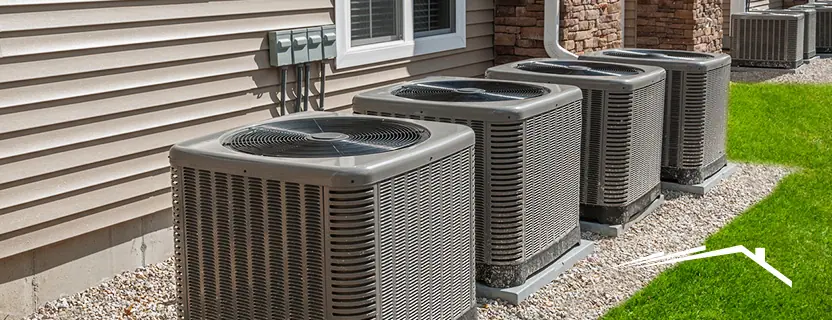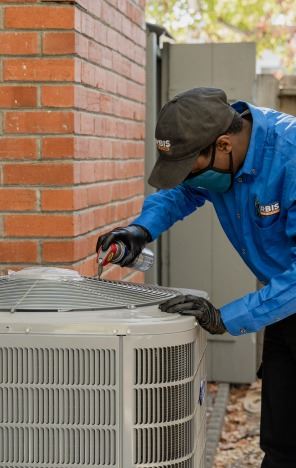Just How a Heatpump and Furnace Collaborate to Maximize Your Home's Home heating Efficiency
Understanding exactly how a heat pump and heating system interact is important for property owners seeking efficient heating solutions. Each system has its staminas, supplying a balanced strategy to home comfort. The heatpump masters modest temperature levels, while the heater delivers rapid heat throughout extreme cold. This harmony not only decreases energy prices however likewise boosts the life expectancy of both home appliances. What factors affect this cooperation, and exactly how can house owners maximize their benefits?
Recognizing Warmth Pumps: Exactly How They Function
Lots of individuals may be strange with their internal operations, warm pumps play a necessary function in contemporary home heating systems. These tools operate by moving warmth from one location to one more, utilizing the concepts of thermodynamics. In cooler months, a heatpump essences heat from the outdoors air, ground, or water, and transfers it inside your home to warm the living space. Conversely, throughout warmer months, it can turn around the process, functioning as an a/c unit by expelling heat from inside to the outside.Heat pumps consist of an evaporator, compressor, growth, and condenser valve. The refrigerant within the system absorbs warmth as it evaporates at low temperature levels and pressures. The compressor after that raises the stress and temperature level of the refrigerant, allowing it to release heat as it condenses. This effective procedure can considerably minimize energy consumption compared to typical home heating techniques, making warmth pumps a lasting choice for environment control in homes.
The Role of Furnaces in Home Home Heating
Heaters play a vital function in home heating by offering a reputable source of warmth throughout the cooler months. They run by creating warmth through combustion or electric resistance, dispersing it throughout the home using air ducts or glowing systems. The efficiency of a heater is commonly measured by its Yearly Gas Utilization Efficiency (AFUE) ranking, which shows how efficiently the unit transforms gas right into heat.Furnaces can make use of various power sources, including all-natural gas, oil, electrical energy, or lp, permitting home owners to choose the most ideal choice for their needs. Unlike warmth pumps, which may struggle in severe cold, furnaces maintain consistent efficiency, making sure that indoor temperatures continue to be comfortable no matter of outdoor problems. Additionally, contemporary heaters typically come geared up with sophisticated innovation, such as smart thermostats and variable-speed blowers, improving their performance and responsiveness. This flexibility makes heating systems an important part in comprehensive home heating techniques.

Advantages of Using Both Equipments Together
Combining the toughness of both furnaces and warmth pumps can bring about an extra reliable and effective home heating remedy. Using both systems enables house owners to benefit from the heatpump's energy efficiency during milder temperatures while depending on the heater for more severe cold problems. This dual strategy can substantially lower energy expenses, as heatpump consume less electricity than conventional home heating techniques when temperature levels are moderate.Additionally, making use of both systems together can boost convenience levels in the home. Heat pumps can supply consistent, also home heating, while heaters can promptly increase ambient temperature levels when needed. The combination of both systems can expand the life expectancy of tools by lowering wear and tear on each device, as they share the work. Eventually, homeowners can delight in a balanced, economical heating option that readjusts seamlessly to varying climate condition, making certain a cozy and inviting home throughout the winter season.
Just How Warm Pumps and Furnaces Enhance Each Other
They produce a corresponding home heating system that takes full advantage of effectiveness and comfort when home owners integrate warm pumps and furnaces. Warmth pumps run by transferring heat from the outdoors air or ground, making them very efficient in modest environments. They succeed during milder temperatures, giving economical heating. Conversely, heaters create heat through combustion or electrical resistance, delivering solid, instant heat throughout extreme cold conditions.The combination of these two systems enables dynamic adjustments based upon temperature level fluctuations. Throughout warmer months or milder wintertime days, the heatpump can take the lead, conserving power and minimizing costs. As temperature levels decline, the heating system can seamlessly involve, making certain constant warmth throughout the home. This harmony not only maximizes power usage but also enhances the life-span of both systems, as each device runs within its ideal efficiency variety. Together, they develop a balanced atmosphere that adjusts to differing climate needs.
Maximizing Efficiency: Tips for Homeowners
Property owners can boost their home heating performance through several functional methods. Establishing a normal upkeep timetable, integrating clever thermostat modern technology, and carrying out efficient insulation and securing remedies are crucial actions. These measures not only enhance comfort yet also reduce power costs.
Regular Upkeep Schedule
To assure optimal heating effectiveness, developing a normal upkeep timetable is vital for any home. Homeowners need to focus on routine evaluations of both warmth pumps and furnaces to establish peak efficiency. This consists of transforming air filters each to 3 months, as blocked filters can considerably minimize performance. Furthermore, organizing professional upkeep a minimum of yearly allows professionals to identify and deal with prospective issues before they escalate. Property owners ought to also clean up the heatpump's outdoor unit to prevent particles buildup that can impede air movement. By sticking look these up to a normal maintenance routine, property owners not just improve their heating systems' performance however also expand their life expectancy, causing greater convenience and decreased energy prices throughout the colder months.
Smart Thermostat Integration
Integrating a smart thermostat right into a home heating system can greatly improve energy effectiveness, particularly as it permits for exact control over temperature level setups. These devices can find out the homeowner's schedule and choices, immediately adjusting the temperature to maximize comfort while lessening energy usage. For example, they can reduce heating during times when the home is vacant, lowering unneeded intake. Lots of smart thermostats also supply real-time power usage information, making it possible for house owners to make enlightened choices regarding their heating behaviors. Additionally, remote gain access to using smartphone applications permits individuals to change settings from anywhere, guaranteeing the home is warm upon return. Overall, clever thermostat combination not just enhances convenience yet substantially adds to power cost savings and efficiency.
Insulation and Sealing Solutions
Smart thermostats play a crucial function in power efficiency, but their effectiveness can be substantially boosted by correct insulation and sealing solutions. Homeowners ought to focus on protecting wall surfaces, attics, and floorings to minimize warmth loss. Top quality insulation materials, such as spray foam or fiberglass, can significantly boost thermal resistance. Furthermore, securing spaces around doors, windows, and air ducts stops cold air infiltration and warm retreat. Weatherstripping and caulking are reliable techniques for attending to these leaks - heat pump service. Normal assessments for air leakages, along with making use of blower door examinations, can aid identify issue areas. By spending in insulation and securing, property owners can enhance the efficiency of their home heating systems, eventually resulting in decreased power intake and reduced utility costs
Typical Myths Concerning Warm Pumps and Furnaces
What mistaken beliefs surround heatpump and furnaces? Many individuals erroneously believe that warm pumps are ineffective in cooler climates. Actually, contemporary heatpump are created to operate effectively even in low temperature levels, supplying dependable heating throughout winter season. visite site An additional usual myth is that furnaces are constantly more effective than heat pumps. This depends on the certain power sources and efficiency scores of the devices in inquiry. Some may likewise assume that using both systems at the same time is unnecessary, but in fact, this combination can enhance heating efficiency, particularly during extreme weather. Additionally, individuals often assume that heatpump need constant upkeep, when actually, they have similar upkeep needs to conventional heating unit. By unmasking these myths, house owners can make even more enlightened decisions regarding their heating choices, inevitably leading to improved comfort and power effectiveness in their homes.
Maintenance Considerations for Combined Systems

Often Asked Questions
Can Warm Pumps Job Properly in Very Cold Climates?
Warm pumps can struggle in extremely cool climates because of minimized performance and warmth removal constraints. Nonetheless, innovations in modern technology have actually resulted in models designed for much better performance in such conditions, enhancing their stability in severe settings.
How Much Time Do Warm Pumps and Furnaces Generally Last?
Heatpump commonly last 15 to two decades, while heaters have a life-span of 15 to three decades. Normal upkeep can prolong their longevity, making sure effective procedure and minimizing the demand for early substitutes.

What Is the Ordinary Expense of Putting Up Both Systems?
The ordinary price of installing both a warm pump and a furnace generally varies between $5,000 to $10,000 - furnace replacement. Factors affecting this expense consist of system dimension, installation complexity, and regional labor rates
Exist Tax Rewards for Making Use Of Energy-Efficient Home Heating Solutions?
Numerous home owners ask about tax obligation motivations for energy-efficient heating systems. Different federal and state programs commonly use credit ratings or refunds, motivating the fostering of lasting technologies to lower energy intake and promote environmental obligation.
How Do I Pick the Right Size Heatpump and Furnace?
Choosing the appropriate size heatpump and furnace includes calculating the home's square video, considering insulation quality, and evaluating neighborhood environment. Consulting a specialist can ensure excellent system performance and energy efficiency based upon details requirements. heat pump service. Recognizing how a heat pump and heater work together is necessary for home owners looking for reliable heating options. In chillier months, a heat pump essences warmth from the outdoors air, ground, or water, and transfers it inside to warm up the living see this site room. When property owners incorporate warm pumps and heating systems, they create a complementary home heating system that makes the most of efficiency and comfort. Warm pumps run by transferring heat from the outdoors air or ground, making them very reliable in moderate environments. Warm pumps can battle in very chilly climates due to lowered efficiency and warmth extraction restrictions